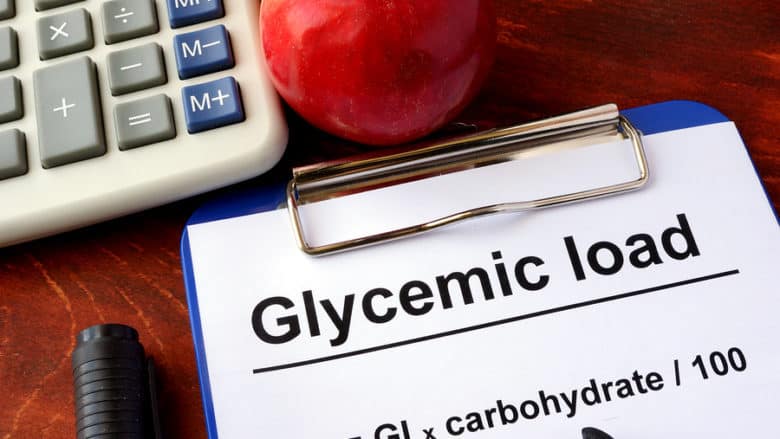
Glycemic load and its partner glycemic index work as science-based tools for selecting “Good Carbohydrates” (low-glycemic) foods.
Eating low-glycemic food helps you break out of the “High-Glycemic Trap” also known as carbohydrate addiction. High-Glycemic foods spike your blood sugar. They give you a sugar rush (high energy) followed by the low blood sugar blues: low energy, weakness, and food craving.
When your blood sugar is low, it’s not a lack of will power that drives you to eat, it’s your body’s undeniable attempt to right itself. If you reach for another high-glycemic food, the cycle repeats.
It dooms your attempt to lose pounds. And… even worse, it wears out your body and can lead to chronic diseases like heart disease and diabetes type 2.
To break this cycle, choose low-glycemic carbohydrates, “Good Carbohydrates.” These foods prime your metabolism to burn fat. They support natural healing.
How to Choose Good Carbs
Here’s a quick review of some general tips for choosing low-glycemic foods from the article, “How to Lose Pounds and Gain Health.”
- Chose whole foods over processed foods.Most refined starchy foods and highly processed foods as well as sugary foods like cookies, candy, and soft drinks are high-glycemic. Whole foods like fruits, vegetables, and legumes are low-glycemic.
- Chose high fiber foods.The higher the fiber content the lower the glycemic level. Most fruits and vegetable are naturally high in fiber. When buying packaged food like bread and pastas, compare their fiber content (found on the food facts label). High fiber foods fill you up faster, so you tend to eat less too.
- Heat can make low-glycemic foods, high-glycemic foods.That’s why almost all raw foods are low-glycemic. Cooking breaks down the starches in foods making them easier to digest so they raise your blood sugar faster. When cooking, lightly steam vegetables and undercook pasta so that it is somewhat firm (al dente).
Food Scientists use the Glycemic Index and Glycemic Load to determine the glycemic level of food.
Glycemic index (GI) indicates the rate blood sugar rises after eating a particular food relative to its rise after eating glucose (sugar). Some scientists use white bread for this comparison, but comparison to sugar is becoming the preferred method.
The Home of Glycemic Index website provides a free database to check the GI index and the GL index of foods. Here’s a guide showing which GI numbers are considered high, medium, or low:
- High Glycemic Index is 70 and Above
- Medium Glycemic Index is 56 to 69
- Low Glycemic Index is 55 and Under
Glycemic load (GL) describes both the quality of carbohydrates (GI) and the quantity of carbohydrates in food. It’s calculated by the weighted average glycemic index of a food multiplied by the percentage of dietary energy as carbohydrates or calories the food contains. Ray Strand, MD, in his book, Healthy for Life, offers this formula.
Glycemic load = (Glycemic Index times Grams of Carbohydrate) divided by 100.
Example: Carrots have a glycemic index of 49 and the average serving contains 5 Grams of Carbohydrates. The glycemic load is (49 times 5) divided by 100 to equal 2.4.
A particular carbohydrate may have a high-glycemic index but is low in calories, like carrots (GI of 49 and GL of 2.4), or they may have a high-glycemic index and be high in calories, like baked potatoes (GI of 85 and GL of 26). Carrots are a good choice while baked potatoes are not.
Food Scientists’ provide the following examples of the glycemic index (GI) and glycemic load (GL) of carbohydrate foods (from the online Micronutrient Information Center at Oregon State University’s Linus Pauling Institute):
Pasta and how heat can increase the GI and GL of foods:
- Spaghetti, white (1 cup) when boiled 10 to 15 minutes has a GI of 44 and a GL of 18
- Spaghetti, white (1 cup) when boiled 5 minutes has a GI of 38 and a GL of 15
Breads and cereals are a big source of carbohydrates in most people’s meals… it pays to choose them wisely:
- White bread (1 large slice) has a GI of 73 and a GL of 10
- Rye, pumpernickel bread (1 large slice) has a GI of 41 and a GL of 5
- Cornflakes (1 cup) has a GI of 81 and GL of 21
- All-Bran™ (1 cup) has a GI of 38 and a GL of 9
Fruits and nuts are good choices… low in glycemic load:
- Apple (raw, medium) has a GI of 38 and a GL of 6
- Cashew nuts (1 oz.) has a GI of 22 and a GL of 2
- Peanuts (1 oz.) has a GI of 14 and a GL of 1
Use the glycemic load and the glycemic index to choose “Good Carbohydrates” so you can set yourself free of the High-Glycemic-Trap… carbohydrate addiction. You’ll lose pounds and gain health too!
You can learn more about Glycemic Index and Glycemic Load at these sites:
Micronutrient Information Center at Oregon State University’s Linus Pauling Institute
